英语-发音规则弱读
英文缩读和弱读规律表(免费)很好哦~~
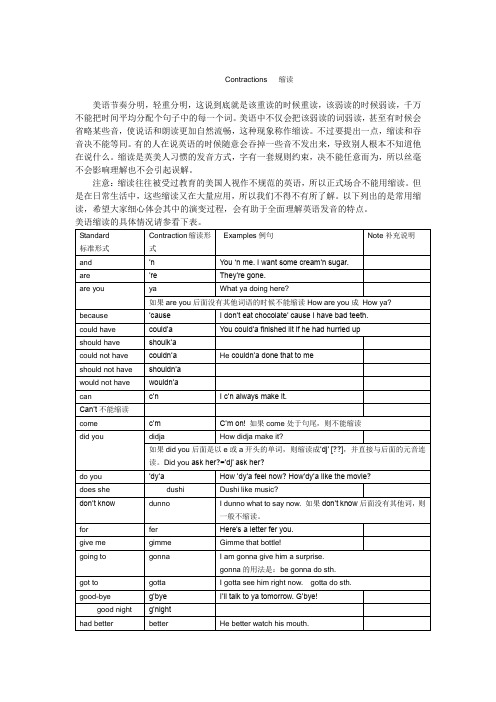
Contractions 缩读美语节奏分明,轻重分明,这说到底就是该重读的时候重读,该弱读的时候弱读,千万不能把时间平均分配个句子中的每一个词。
美语中不仅会把该弱读的词弱读,甚至有时候会省略某些音,使说话和朗读更加自然流畅,这种现象称作缩读。
不过要提出一点,缩读和吞音决不能等同。
有的人在说英语的时候随意会吞掉一些音不发出来,导致别人根本不知道他在说什么。
缩读是英美人习惯的发音方式,字有一套规则约束,决不能任意而为,所以丝毫不会影响理解也不会引起误解。
注意:缩读往往被受过教育的美国人视作不规范的英语,所以正式场合不能用缩读。
但是在日常生活中,这些缩读又在大量应用,所以我们不得不有所了解。
以下列出的是常用缩读,希望大家细心体会其中的演变过程,会有助于全面理解英语发音的特点。
Weak Forms 弱读在英语中,与句重音相对应的出现的是非重读音节,它们一起构成了句子的高低起伏,强弱交替的节奏模式,形成具有表意功能的连贯句子。
这些非重读音节体现在单个单词中就是常说的某些单音节的弱读或非重读(unstressed syllable)。
英语是节奏感很强的语言,要掌握好英语节奏,首先要熟悉强读式(strong forms)和弱读式(weak forms),它对语言连贯、流畅性起着重要的作用。
一、强读和弱读强读和弱读实际就是重读和弱读,一句话中至少有一个重要的音节要重读,其他音节相应弱读。
重读音节从音高和音强上应该big, strong, important loudly,非重读音节(弱读)就应该是weak or small or quiet。
强读和弱读通过一定形式在句子中体现,英语中有接近五十多个单音节词有两种读音形式:弱读形式和强读形式。
在连贯的语言中弱读形式的使用比强读形式更多,更重要。
重读或强读形式其实是单个单词发音的基本形式,即音标中的读音形式,而弱读形式从音质上和强读形式比较起来短而轻;在前面学习中,我们知道短元音/ə/和/i/常出现在非重读音节中,因此多数弱读形式体现也以/ə/或/i/体现。
英语中的弱读规则
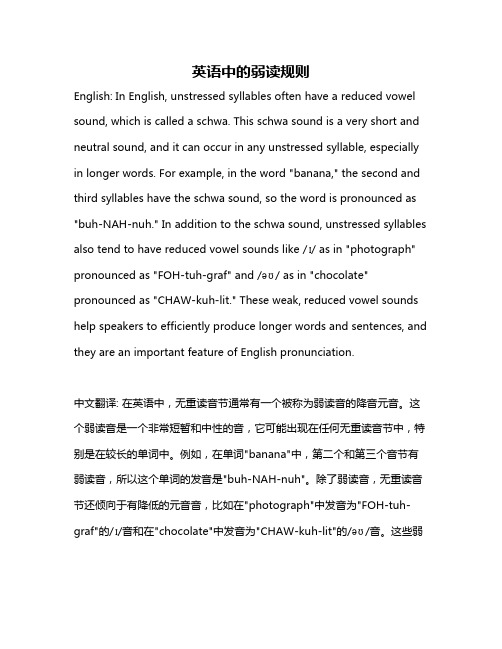
英语中的弱读规则English: In English, unstressed syllables often have a reduced vowel sound, which is called a schwa. This schwa sound is a very short and neutral sound, and it can occur in any unstressed syllable, especially in longer words. For example, in the word "banana," the second and third syllables have the schwa sound, so the word is pronounced as "buh-NAH-nuh." In addition to the schwa sound, unstressed syllables also tend to have reduced vowel sounds like /ɪ/ as in "photograph" pronounced as "FOH-tuh-graf" and /əʊ/ as in "chocolate" pronounced as "CHAW-kuh-lit." These weak, reduced vowel sounds help speakers to efficiently produce longer words and sentences, and they are an important feature of English pronunciation.中文翻译: 在英语中,无重读音节通常有一个被称为弱读音的降音元音。
最新英语连读和弱读的发音规则
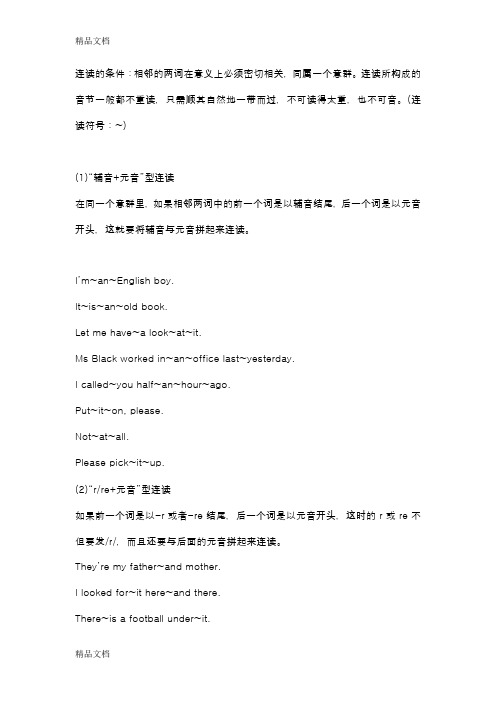
连读的条件:相邻的两词在意义上必须密切相关,同属一个意群。
连读所构成的音节一般都不重读,只需顺其自然地一带而过,不可读得太重,也不可音。
(连读符号:~)(1)“辅音+元音”型连读在同一个意群里,如果相邻两词中的前一个词是以辅音结尾,后一个词是以元音开头,这就要将辅音与元音拼起来连读。
I’m~an~English boy.It~is~an~old book.Let me have~a look~at~it.Ms Black worked in~an~office last~yesterday.I called~you half~an~hour~ago.Put~it~on, please.Not~at~all.Please pick~it~up.(2)“r/re+元音”型连读如果前一个词是以-r或者-re结尾,后一个词是以元音开头,这时的r或re不但要发/r/,而且还要与后面的元音拼起来连读。
They’re my father~and mother.I looked for~it here~and there.There~is a football under~it.There~are some books on the desk.Here~is a letter for you.Here~are four~eggs.But where~is my cup?Where~are your brother~and sister?但是,如果一个音节的前后都有字母r,即使后面的词以元音开头,也不能连读。
The black clouds are coming nearer and nearer.(nearer与and不可连读)(3)“辅音+半元音”型连读英语语音中的/j/和/w/是半元音,如果前一个词是以辅音结尾,后一个词是以半元音,特别是/j/开头,此时也要连读。
Thank~you.Nice to meet~you.Did~you get there late~again?Would~you like~a cup~of tea?Could~you help me, please?“音的同化”—常把/d/+/j/读成/dV/,did you听上成了/dIdVu/,would you成了/wudVu/,could you成了/kudVu/。
英语发音规则—爆破、弱读及连读

一、语音外国人说英语与中国人说汉语运气的方式与位置不一样。
外国人说英语很有力道,气一般都提起来了,大致在胸腔附近。
而中国人说汉语则很少提气,把气一般都放在腹腔以下,所以感觉外国人说话声音相对很饱满,有种用“美声”说话的感觉,而中国人则不然。
这点是大家在说英语时应特别感受和注意的。
1.易混音:[i:]——[i] 长音发得不够长,短音发得不够短。
如:ship--sheep; shit--sheet [æ]——[e] 嘴形大小不到位。
如:pat--pet; bad--bed[e]——[ai];[ɔ][ɔ:]——[au] 单元音发得不够短,双元音发得不够饱满。
如:press--price; smell--smile; sauce--south[iә]——[eә] 容易发音不清楚,将其区别弱化或忽略。
如:really--rarely; beer--bear [w]——[v] 嘴形不到位。
如:wave; vowel; very well[r]——[ʒ] 容易与汉语拼音混淆。
如:garage; mirror; measure[s]——[q];[z]——[ð] 注意舌头的具体位置,多加练习。
建议:大家在语音练习过程当中尽量将音标发得饱满和夸张,这样在真正用英语进行对话的时候不会由于紧张导致说出的英语含混不清,让人听不懂。
2.发音规律:1)听力中的元音[æ]。
试比较bar和bath的区别。
Bar中由于有“r”因而有卷舌音,读成[ar],bath中“a”在“th”前(在f、n、s之前也有这种用法),通常读作[æ]。
许多人在发音的时候经常由于嘴形做不大而导致发音不标准,说出来的英语也不尽人意。
很明显,[a:]在美音中常演变成[ar]、[æ]两个音。
例:[ar]: far dark march hard mark start park[æ]: last fast master glass class can‟t2) 听力中的元音长短问题。
弱读规则
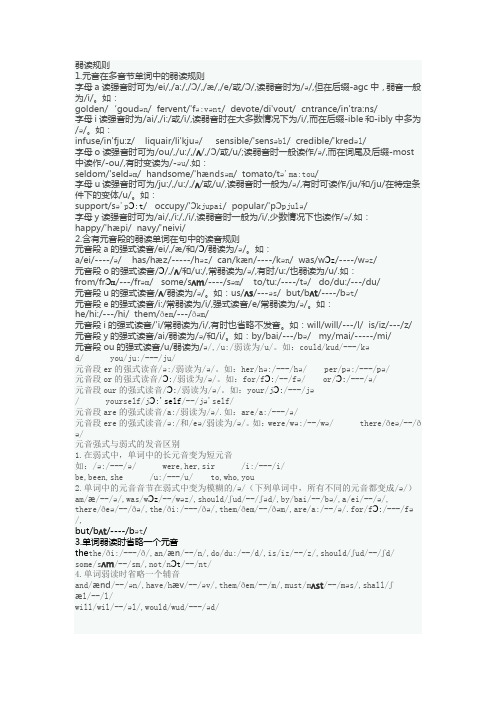
弱读规则1.元音在多音节单词中的弱读规则字母a读强音时可为/ei/,/a:/,/Ɔ/,/æ/,/e/或/Ɔ/,读弱音时为/ə/,但在后缀-agc中,弱音一般为/i/。
如:golden/‘goudən/ fervent/'fə:vənt/ devote/di'vout/ cntrance/in'tra:ns/字母i读强音时为/ai/,/i:/或/i/,读弱音时在大多数情况下为/i/,而在后缀-ible和-ibly中多为/ə/。
如:infuse/in'fju:z/ liquair/li'kjuə/ sensible/'sensəbl/ credible/'kredəl/字母o读强音时可为/ou/,/u:/,/ʌ/,/Ɔ/或/u/;读弱音时一般读作/ə/,而在词尾及后缀-most 中读作/-ou/,有时变读为/-əu/.如:seldom/'seldəm/ handsome/'hændsəm/ tomato/tə'ma:tou/字母u读强音时可为/ju:/,/u:/,/ʌ/或/u/,读弱音时一般为/ə/,有时可读作/ju/和/ju/在特定条件下的变体/u/。
如:support/sə'pƆ:t/ occupy/'Ɔkjupai/ popular/'pƆpjulə/字母y读强音时可为/ai/,/i:/,/i/,读弱音时一般为/i/,少数情况下也读作/ə/.如:happy/'hæpi/ navy/'neivi/2.含有元音段的弱读单词在句中的读音规则元音段a的强式读音/ei/,/æ/和/Ɔ/弱读为/ə/。
如:a/ei/----/ə/ has/hæz/-----/həz/ can/kæn/----/kən/ was/wƆz/----/wəz/元音段o的强式读音/Ɔ/,/ʌ/和/u:/,常弱读为/ə/,有时/u:/也弱读为/u/.如:from/frƆm/---/frəm/ some/sʌm/----/səm/ to/tu:/----/tə/ do/du:/---/du/元音段u的强式读音/ʌ/弱读为/ə/。
英语发音规则---浊化、连读、弱化、爆破...
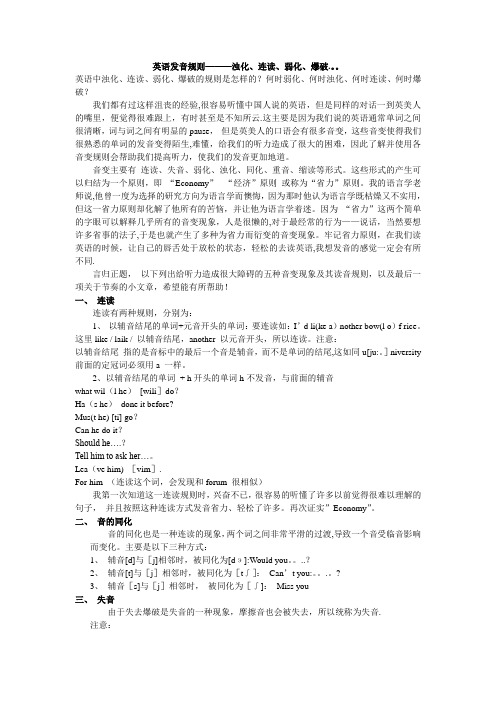
英语发音规则———浊化、连读、弱化、爆破.。
英语中浊化、连读、弱化、爆破的规则是怎样的?何时弱化、何时浊化、何时连读、何时爆破?我们都有过这样沮丧的经验,很容易听懂中国人说的英语,但是同样的对话一到英美人的嘴里,便觉得很难跟上,有时甚至是不知所云.这主要是因为我们说的英语通常单词之间很清晰,词与词之间有明显的pause,但是英美人的口语会有很多音变,这些音变使得我们很熟悉的单词的发音变得陌生,难懂,给我们的听力造成了很大的困难,因此了解并使用各音变规则会帮助我们提高听力,使我们的发音更加地道。
音变主要有连读、失音、弱化、浊化、同化、重音、缩读等形式。
这些形式的产生可以归结为一个原则,即“Economy”-“经济”原则或称为“省力”原则。
我的语言学老师说,他曾一度为选择的研究方向为语言学而懊悔,因为那时他认为语言学既枯燥又不实用,但这一省力原则却化解了他所有的苦恼,并让他为语言学着迷。
因为“省力”这两个简单的字眼可以解释几乎所有的音变现象,人是很懒的,对于最经常的行为——说话,当然要想许多省事的法子,于是也就产生了多种为省力而衍变的音变现象。
牢记省力原则,在我们读英语的时候,让自己的唇舌处于放松的状态,轻松的去读英语,我想发音的感觉一定会有所不同.言归正题,以下列出给听力造成很大障碍的五种音变现象及其读音规则,以及最后一项关于节奏的小文章,希望能有所帮助!一、连读连读有两种规则,分别为:1、以辅音结尾的单词+元音开头的单词:要连读如:I’d li(ke a)nother bow(l o)f rice。
这里like / laik / 以辅音结尾,another 以元音开头,所以连读。
注意:以辅音结尾指的是音标中的最后一个音是辅音,而不是单词的结尾,这如同u[ju:。
]niversity 前面的定冠词必须用a 一样。
2、以辅音结尾的单词+ h开头的单词h不发音,与前面的辅音what wil(l he)[wili]do?Ha(s he)done it before?Mus(t he) [ti] go?Can he do it?Should he….?Tell him to ask her…。
英语中读音中强读、弱读、连读、失爆等规则
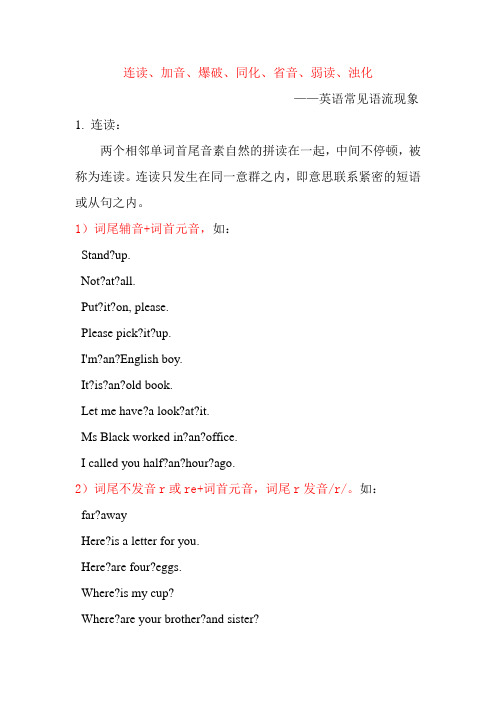
连读、加音、爆破、同化、省音、弱读、浊化——英语常见语流现象1.连读:两个相邻单词首尾音素自然的拼读在一起,中间不停顿,被称为连读。
连读只发生在同一意群之内,即意思联系紧密的短语或从句之内。
1)词尾辅音+词首元音,如:Stand?up.Not?at?all.Put?it?on, please.Please pick?it?up.I'm?an?English boy.It?is?an?old book.Let me have?a look?at?it.Ms Black worked in?an?office.I called you half?an?hour?ago.2)词尾不发音r或re+词首元音,词尾r发音/r/。
如:far?awayHere?is a letter for you.Here?are four?eggs.Where?is my cup?Where?are your brother?and sister?They're my father?and mother.I looked for?it here?and there.There?is a football under?it.There?are some books on the desk.注:当有意群进行停顿时不可连读。
如:Is?it a hat or?a cat?(hat 与or 之间不可以连读)There?is?a good book in my desk.(book 与in 之间不可以连读)Can you speak?English or French?(English 与or 之间不可以连读)Shall we meet at?eight or ten tomorrow morning? (meet 与at eight 与or 之间不可以连读)She opened the door and walked?in. (door 与and 之间不可以连读)2.加音:在连贯的语流中,人们往往会在两个元音之间加入一个外加音帮助发音,从而更加流畅地表达意思。
英语发音连读失去爆破重读弱读英语中常见的发音规则及现象入门必备
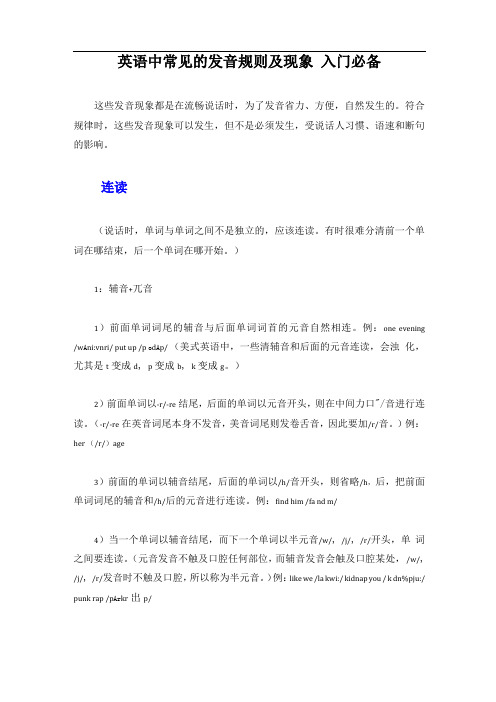
英语中常见的发音规则及现象入门必备这些发音现象都是在流畅说话时,为了发音省力、方便,自然发生的。
符合规律时,这些发音现象可以发生,但不是必须发生,受说话人习惯、语速和断句的影响。
连读(说话时,单词与单词之间不是独立的,应该连读。
有时很难分清前一个单词在哪结束,后一个单词在哪开始。
)1:辅音+兀音1)前面单词词尾的辅音与后面单词词首的元音自然相连。
例:one evening /w A ni:vnri/ put up /p o d A p/ (美式英语中,一些清辅音和后面的元音连读,会浊化,尤其是t变成d, p变成b, k变成g。
)2)前面单词以-r/-re结尾,后面的单词以元音开头,则在中间力口"/音进行连读。
(-r/-re在英音词尾本身不发音,美音词尾则发卷舌音,因此要加/r/音。
)例:her (/r/)age3)前面的单词以辅音结尾,后面的单词以/h/音开头,则省略/h,后,把前面单词词尾的辅音和/h/后的元音进行连读。
例:find him /fa nd m/4)当一个单词以辅音结尾,而下一个单词以半元音/w/, /j/, /r/开头,单词之间要连读。
(元音发音不触及口腔任何部位,而辅音发音会触及口腔某处,/w/, /j/, /r/发音时不触及口腔,所以称为半元音。
)例:like we /la kwi:/ kidnap you / k dn%pju:/ punk rap /p Ar kr出p/2:辅音+辅音两个相同的辅音的合并:前一个单词以辅音结尾,后一个单词以相同的辅音开头,发音时只发一个拖长的辅音。
例:some milk /s A m i k/ (some 中的 e 本身不发音)it’s half full /h o:f o l/ (half 中的l本身不发音)3:兀音+兀音1)用/w/连接两个元音。
前面的单词以元音/u:/,/a。
/,/so/结尾,后面的单词以元音开头,则在中间加/w/来连接两个元音。
美音连读与发音规则

2.元音对元音的连读
在元音之间插入[j]或[w], 从而使纯元音 音节之间的过渡变得自然、流畅,读起 来更加上口。
元音与元音怎么连读?
2.元音对元音的连读
★ ⑴ 前面的单词以元音[e]或[i]或[ai]结尾,紧随
其后的单词以元音开头,这时,在两个单词之间 出现[j]作为过渡。
①day in and day out ; ②Can you see it(try it)?
① say it ②stay up ③very interesting ④she is ⑤copy it ⑥he and she
2.元音对元音的连读
★ ⑴ 前面的单词以元音[e]或[i]或[ai]结尾,紧随
其后的单词以元音开头,这时,在两个单词之间 出现[j]作为过渡。
①day in and day out ; ②Can you see it(try it)?
2.元音对元音的连读
★ ⑴ 前面的单词以元音[e]或[i]或[ai]结尾,紧随
其后的单词以元音开头,这时,在两个单词之间 出现[j]作为过渡。
①day in and day out ; ②Can you see it(try it)?
★ ⑵前面的单词以[u]或[o]或[au]结尾,紧随其后的单词
以元音开头,这时,在两个单词之间出现[w]作为过渡。 ① Can you do it? ② Go away ③How are you doing?
◆元音间连读规则总结
1. /i/ + 元音 中间加/ j/ 2. /u/ + 元音 中间加 /w/;
连读规则总结 同一意群 前辅后元 前元后元
连读
1. 辅音与元音之间的连读 2. 元音与元音之间的连读
英语3种发音规则

英语3种发音规则
英语发音规则主要有三种:
1. 连读:在一个句子中,如果相邻的两个词前者以辅音音素结尾,后者以元音音素开头,就要自然地把辅音和元音相拼,构成一个音节。
如“I am”就可以直接读成“A main”。
2. 省音:在读合成词时,有些词的前一个词的最后一个音节与后一个词的第一个音节相同,发音时可以省去这个重复的音节。
如“EEP”可以省去“E”音节,发音为“IP”。
3. 弱读:在英语中,句子中的单词有强有弱,强读是指单词中的每一个音节都发音清晰,而弱读则是指单词中的某些音节不发音或发音轻化。
例如,“is”中的“s”通常不发音,“of”中的“f”可以弱化为“v”。
以上是三种常见的英语发音规则,希望对您有所帮助。
英语-发音规则弱读
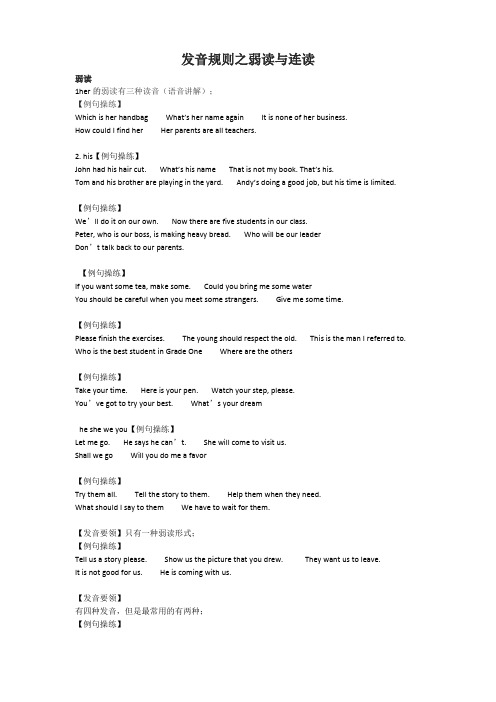
发音规则之弱读与连读弱读1her的弱读有三种读音(语音讲解);【例句操练】Which is her handbag What’s her name again It is none of her business.How could I find her Her parents are all teachers.2. his【例句操练】John had his hair cut. What’s his name That is not my book. That’s his.Tom and his brother are playing in the yard. Andy’s doing a good job, but his time is limited.【例句操练】We’ll do it on our own. Now there are five students in our class.Peter, who is our boss, is making heavy bread. Who will be our leaderDon’t talk back to our parents.【例句操练】If you want some tea, make some. Could you bring me some waterYou should be careful when you meet some strangers. Give me some time.【例句操练】Please finish the exercises. The young should respect the old. This is the man I referred to. Who is the best student in Grade One Where are the others【例句操练】Take your time. Here is your pen. Watch your step, please.You’ve got to try your best. What’s your dreamhe she we you【例句操练】Let me go. He says he can’t. She will come to visit us.Shall we go Will you do me a favor【例句操练】Try them all. Tell the story to them. Help them when they need.What should I say to them We have to wait for them.【发音要领】只有一种弱读形式;【例句操练】Tell us a story please. Show us the picture that you drew. They want us to leave.It is not good for us. He is coming with us.【发音要领】有四种发音,但是最常用的有两种;【例句操练】Can I have some tea with ice and lemon Bread and butter, please.I have told him over and over again. I don’t like cats and dogs.He bought his hat and coat in this new store.【发音要领】一种弱读发音;【例句操练】It is as cold as ice. He is as happy as a king. Please do as I do.He runs as fast as he can. As far as I am concerned, I don’t like it.【发音要领】有一种弱读形式;【例句操练】I am ugly, but I am gentle. They said but they didn’t do it. She is tired but happy.Last but not least, treasure the time. I’ll do anything but that.【发音要领】其中的字母a弱读;【例句操练】My sister’s prettier than yours. It’s easier than I expected.It’s bigger than this. He is better than others. I love you more than I can say.【发音要领】其中的字母a弱读;【例句操练】He said that I could get it. Tell her that I am not going. We all know that we face problems. We are all aware that the difficulties are not so easy to overcome.It is true that no man can succeed without sweat.动词【发音要领】am中的a弱读,is中的i弱读,are弱读并变短音,be变短音;【例句操练】I’m surprised. Am I right What are you going to doDon’t be nervous. She’s a very good secretary.16. Do/does【发音要领】do, does中的字母o都要弱读;【例句操练】Do you understand Do you know them What does she do for a livingWhat time does the train arrive What sort of family does he come fromhas had【发音要领】其中的字母a弱读;【例句操练】Charles has bought a car. You’d better put it back. The bus had already left.I have finished my assignment. They may have gone.shall will must【发音要领】其中的字母a和i弱读;【例句操练】I must go now. Everyone must have a paper. What can I do at that timeThat will do. Shall I open the window【发音要领】一种弱读形式。
英语弱读技巧和规律
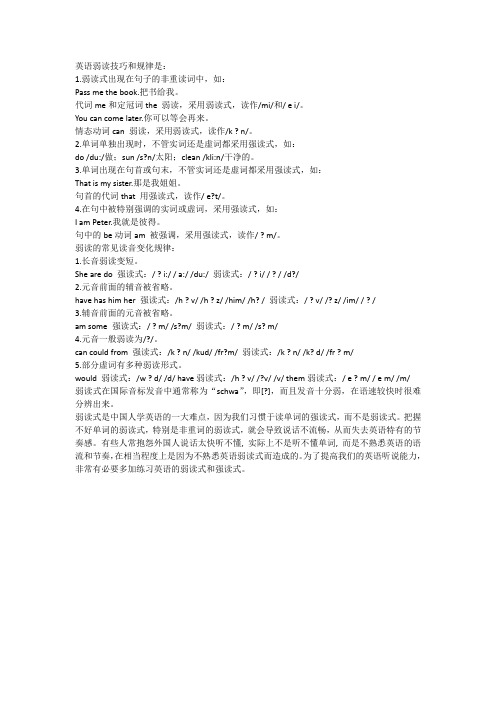
英语弱读技巧和规律是:1.弱读式出现在句子的非重读词中,如:Pass me the book.把书给我。
代词me和定冠词the 弱读,采用弱读式,读作/mi/和/ e i/。
You can come later.你可以等会再来。
情态动词can 弱读,采用弱读式,读作/k ? n/。
2.单词单独出现时,不管实词还是虚词都采用强读式,如:do /du:/做;sun /s?n/太阳;clean /kli:n/干净的。
3.单词出现在句首或句末,不管实词还是虚词都采用强读式,如:That is my sister.那是我姐姐。
句首的代词that 用强读式,读作/ e?t/。
4.在句中被特别强调的实词或虚词,采用强读式,如:I am Peter.我就是彼得。
句中的be动词am 被强调,采用强读式,读作/ ? m/。
弱读的常见读音变化规律:1.长音弱读变短。
She are do 强读式:/ ? i:/ / a:/ /du:/ 弱读式:/ ? i/ / ? / /d?/2.元音前面的辅音被省略。
have has him her 强读式:/h ? v/ /h ? z/ /him/ /h? / 弱读式:/ ? v/ /? z/ /im/ / ? /3.辅音前面的元音被省略。
am some 强读式:/ ? m/ /s?m/ 弱读式:/ ? m/ /s? m/4.元音一般弱读为/?/。
can could from 强读式:/k ? n/ /kud/ /fr?m/ 弱读式:/k ? n/ /k? d/ /fr ? m/5.部分虚词有多种弱读形式。
would 弱读式:/w ? d/ /d/ have弱读式:/h ? v/ /?v/ /v/ them弱读式:/ e ? m/ / e m/ /m/弱读式在国际音标发音中通常称为“schwa”,即[?],而且发音十分弱,在语速较快时很难分辨出来。
弱读式是中国人学英语的一大难点,因为我们习惯于读单词的强读式,而不是弱读式。
英语中的连读、弱读、缩读规则(附音标)

英语中的连读、弱读、缩读规则(附音标)英语中地道的发音离不开连读、弱读和缩读等技巧,要掌握这些规则,看完这一篇就可以了。
连读规则一、辅音+元音如果一个单词的最后一个音是辅音,后面单词的第一个音是元音,这个时候辅音和元音合在一起读成一个音,就好像读成一个单词一样。
比如常见的辅音:1.【s】lots of 辅音在前,元音在后,就可以连读[lɑːtsʌv]2.辅音【m】come on 连读为[kʌmɑːn]3.辅音【n】an hour 连读为[ænˈaʊər] (hour 的h 不发音)4.辅音【t】get up 连读为[ɡetʌp]5.辅音【p】keep off 连读为[kiːpɔːf]6.辅音【r】far away 连读为[fɑːrəˈweɪ]7.辅音【l】all of连读为[ɔːlʌv]8.辅音【z】was it 连读为[wʌzɪt]综合短语练习put it off 连读为[pʊt ˆɪt ˆɔːf]pick it up 连读为[pɪk ˆɪt ˆʌp]get out of 连读为[ɡet ˆaʊt ˆʌv]haveˆa lookˆatˆit 连读为[hæv ˆəlʊk ˆæt ˆɪt]I look forˆit hereˆand there.连读为[aɪlʊk fɔːr ˆɪt hɪr ˆænd ðer]二、辅音+辅音前一个单词的结尾辅音和后面一个单词开始的辅音相同,只发一次音。
这种情况通常发生在辅音[t][d][k][g][b][p]等辅音出现的时候。
1.first time(t+t),first后面发的是[t],time 第一个音发的也是[t],两个[t]碰到一起,完全一样,两个[t]就只读一次。
2.great teacher(t+t),其中great的尾音[t]和teacher 的前音[t]相同,那么前一个t不发音。
3.take care(k+k)最后一个音发[k],care 第一个字母发[k],两个[k]读成一个[k],读成ta care。
英语——连读、弱读和缩读英语发音规则整理
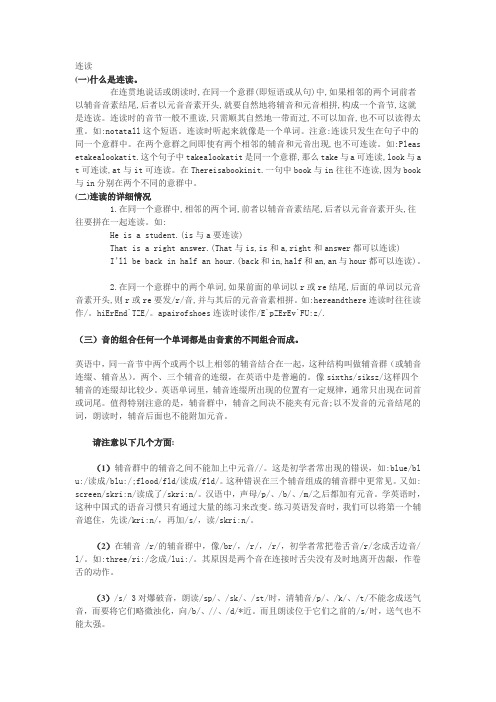
连读(一)什么是连读。
在连贯地说话或朗读时,在同一个意群(即短语或从句)中,如果相邻的两个词前者以辅音音素结尾,后者以元音音素开头,就要自然地将辅音和元音相拼,构成一个音节,这就是连读。
连读时的音节一般不重读,只需顺其自然地一带而过,不可以加音,也不可以读得太重。
如:notatall这个短语。
连读时听起来就像是一个单词。
注意:连读只发生在句子中的同一个意群中。
在两个意群之间即使有两个相邻的辅音和元音出现,也不可连读。
如:Pleas etakealookatit.这个句子中takealookatit是同一个意群,那么take与a可连读,look与a t可连读,at与it可连读。
在Thereisabookinit.一句中book与in往往不连读,因为book 与in分别在两个不同的意群中。
(二)连读的详细情况1.在同一个意群中,相邻的两个词,前者以辅音音素结尾,后者以元音音素开头,往往要拼在一起连读。
如:He is a student.(is与a要连读)That is a right answer.(That与is,is和a,right和answer都可以连读)I’ll be back in half an hour.(back和in,half和an,an与hour都可以连读)。
2.在同一个意群中的两个单词,如果前面的单词以r或re结尾,后面的单词以元音音素开头,则r或re要发/r/音,并与其后的元音音素相拼。
如:hereandthere连读时往往读作/。
hiErEnd`TZE/。
apairofshoes连读时读作/E`pZErEv`FU:z/.(三)音的组合任何一个单词都是由音素的不同组合而成。
英语中,同一音节中两个或两个以上相邻的辅音结合在一起,这种结构叫做辅音群(或辅音连缀、辅音丛)。
两个、三个辅音的连缀,在英语中是普遍的。
像sixths/siksz/这样四个辅音的连缀却比较少。
英语单词里,辅音连缀所出现的位置有一定规律,通常只出现在词首或词尾。
英语弱读的三个原则__概述说明以及解释
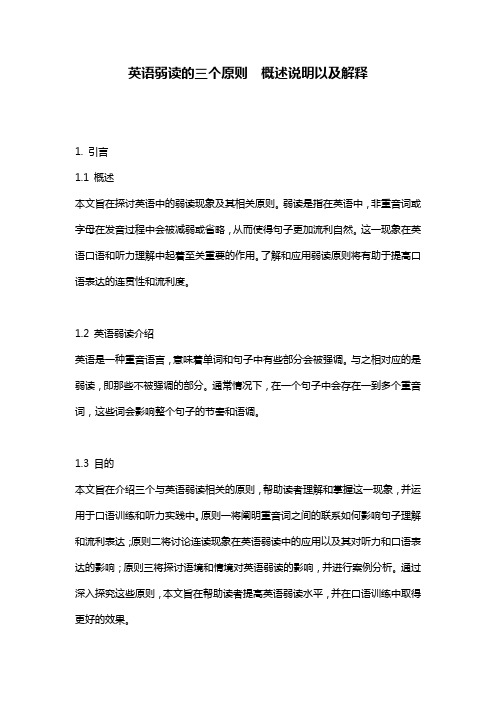
英语弱读的三个原则概述说明以及解释1. 引言1.1 概述本文旨在探讨英语中的弱读现象及其相关原则。
弱读是指在英语中,非重音词或字母在发音过程中会被减弱或省略,从而使得句子更加流利自然。
这一现象在英语口语和听力理解中起着至关重要的作用。
了解和应用弱读原则将有助于提高口语表达的连贯性和流利度。
1.2 英语弱读介绍英语是一种重音语言,意味着单词和句子中有些部分会被强调。
与之相对应的是弱读,即那些不被强调的部分。
通常情况下,在一个句子中会存在一到多个重音词,这些词会影响整个句子的节奏和语调。
1.3 目的本文旨在介绍三个与英语弱读相关的原则,帮助读者理解和掌握这一现象,并运用于口语训练和听力实践中。
原则一将阐明重音词之间的联系如何影响句子理解和流利表达;原则二将讨论连读现象在英语弱读中的应用以及其对听力和口语表达的影响;原则三将探讨语境和情境对英语弱读的影响,并进行案例分析。
通过深入探究这些原则,本文旨在帮助读者提高英语弱读水平,并在口语训练中取得更好的效果。
2. 原则一:句子中重音词之间的联系2.1 强读和弱读的定义在英语中,每个单词都有一个或多个音节。
通常情况下,这些音节中的一个会被发音得更响亮并且更加明显,这就是强读音节。
而其他音节则不发出强烈的声音,这些被称为弱读音节。
强读和弱读对于准确理解和表达英语句子非常重要。
2.2 重音词对句子理解的影响在一句话中,通常有一个或多个单词是重音词,也就是说它们的其中一个或多个音节属于强读音节。
重音词承载着句子中最关键、最具有信息量的部分,因此能够显著影响听者对整个句子意义的理解。
当我们将重点放在重音词上时,可以更好地体现出句子所要表达的含义。
而忽略了或错误地判断了重音词可能导致对句意产生误解。
2.3 弱读如何帮助实现流利口语表达弱读是英语口语流利性的关键之一。
通过正确地运用弱读规则,我们能够在表达时更加自然、流畅地连接单词。
弱读帮助我们快速准确地传递信息,使得语速更快、更接近英语母语者的发音。
英语连读,弱读,爆破音规则

为什么听不懂老外的发音——原来英语有连读、弱读和缩读连读(一)什么是连读.在连贯地说话或朗读时,在同一个意群(即短语或从句)中,如果相邻的两个词前者以辅音音素结尾,后者以元音音素开头,就要自然地将辅音和元音相拼,构成一个音节,这就是连读。
连读时的音节一般不重读,只需顺其自然地一带而过,不可以加音,也不可以读得太重.如:notatall这个短语。
连读时听起来就像是一个单词.注意:连读只发生在句子中的同一个意群中。
在两个意群之间即使有两个相邻的辅音和元音出现,也不可连读。
如:Pleasetakealookatit.这个句子中takealookatit是同一个意群,那么take与a可连读,look与at可连读,at与it可连读。
在Thereisabookinit。
一句中book与in往往不连读,因为book 与in分别在两个不同的意群中.(二)连读的详细情况1。
在同一个意群中,相邻的两个词,前者以辅音音素结尾,后者以元音音素开头,往往要拼在一起连读。
如:He is a student.(is与a要连读)That is a right answer.(That与is,is和a,right和answer都可以连读)I’ll be back in half an hour。
(back和in,half和an,an与hour都可以连读).2.在同一个意群中的两个单词,如果前面的单词以r或re结尾,后面的单词以元音音素开头,则r或re要发/r/音,并与其后的元音音素相拼。
如:hereandthere连读时往往读作/。
hiErEnd`TZE/.apairofshoes连读时读作/E`pZErEv`FU:z/.(三)音的组合任何一个单词都是由音素的不同组合而成。
英语中,同一音节中两个或两个以上相邻的辅音结合在一起,这种结构叫做辅音群(或辅音连缀、辅音丛)。
两个、三个辅音的连缀,在英语中是普遍的.像sixths/siksz/这样四个辅音的连缀却比较少。
英语的弱化,连读,爆破,弱读,同化,浊化规则
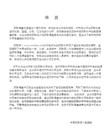
一、 连读
连读有两种规则,分别为:
1、 以辅音结尾的单词+元音开头的单词:要连读
如:I’d li(ke a)nother bow(l o)f rice.
这里like / laik / 以辅音结尾,another 以元音开头,所以连读
注意:
同理,其他元音在第一阶梯的弱化形式为:[U:]弱化为[U],[C:]弱化为[C],[[:]弱化为[[],[ei]弱化为[i]等。
属于这种情况的弱化由于变化较小,在听觉上并不能感到明显的差别,因而也不构成明显听力障碍。故第一阶梯的弱化尚不能造成四级听力的失分。
2)弱化的第二阶梯是所有的元音经过一定程度弱化后都可以变为[[]音,这使元音发生了较大程度的弱化,是所有元音共有的弱化状态,所以弱音中表现形式最多的就是这一[[]音。例如:
并且按照这种连读方式发音省力、轻松了许多。再次证实”Economy”。
二、 音的同化
音的同化也是一种连读的现象,两个词之间非常平滑的过渡,导致一个音受临音影响而变化。主要是以下三种方式:
1、 辅音[d]与[j]相邻时,被同化为[dэ]:Would you....?
2、 辅音[t]与[j]相邻时,被同化为[t∫]: Can’t you:。。。。?
在英语口语中,有时为了加快语速,某些元音会被弱化和弱读。如of"[Cv]"--"[Ev]",but"[bAt]"--"[bEt]",感觉上被弱化的多为较次要的词,如介词,副词etc.
元音弱化遵循着阶梯性的规律:
1)元音弱化的第一阶梯是,如果一个元音的弱化程度不太厉害,则它仅改变为比它低一级的元音发出。如:[i:]可弱化为[i]。如单词he[hi:]在日常口语中最常发出的实际上是[hi]的音,而不是完完全全的[hi:]。只要仔细听一下磁带或体会一下自己以自然速度说口语时的发音就会发现这一点。
英语-发音规则弱读
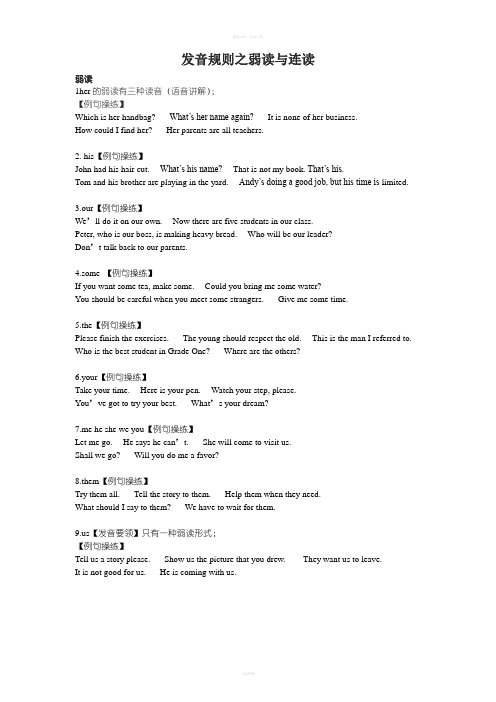
发音规则之弱读与连读弱读1her的弱读有三种读音(语音讲解);【例句操练】Which is her handbag? What’s her name again?It is none of her business.How could I find her? Her parents are all teachers.2. his【例句操练】John had his hair cut. What’s his name?That is not my book. That’s his.Tom and his brother are playing in the yard. Andy’s doing a good job, but his time is limited.3.our【例句操练】We’ll do it on our own. Now there are five students in our class.Peter, who is our boss, is making heavy bread. Who will be our leader?Don’t talk back to our parents.4.some 【例句操练】If you want some tea, make some. Could you bring me some water?You should be careful when you meet some strangers. Give me some time.5.the【例句操练】Please finish the exercises. The young should respect the old. This is the man I referred to. Who is the best student in Grade One? Where are the others?6.your【例句操练】Take your time. Here is your pen. Watch your step, please.You’ve got to try your best. What’s your dream?7.me he she we you【例句操练】Let me go. He says he can’t. She will come to visit us.Shall we go? Will you do me a favor?8.them【例句操练】Try them all. Tell the story to them. Help them when they need.What should I say to them? We have to wait for them.【发音要领】只有一种弱读形式;【例句操练】Tell us a story please. Show us the picture that you drew. They want us to leave.It is not good for us. He is coming with us.10.and【发音要领】有四种发音,但是最常用的有两种;【例句操练】Can I have some tea with ice and lemon? Bread and butter, please.I have told him over and over again. I don’t like cats and dogs.He bought his hat and coat in this new store.11.as【发音要领】一种弱读发音;【例句操练】It is as cold as ice. He is as happy as a king. Please do as I do.He runs as fast as he can. As far as I am concerned, I don’t like it.12.but【发音要领】有一种弱读形式;【例句操练】I am ugly, but I am gentle. They said but they didn’t do it. She is tired but happy.Last but not least, treasure the time. I’ll do anything but that.13.than【发音要领】其中的字母a弱读;【例句操练】My sister’s prettier than yours. It’s easier than I expected.It’s bigger than this. He is better than others. I love you more than I can say.14.that【发音要领】其中的字母a弱读;【例句操练】He said that I could get it. Tell her that I am not going. We all know that we face problems. We are all aware that the difficulties are not so easy to overcome.It is true that no man can succeed without sweat.15.be动词【发音要领】am中的a弱读,is中的i弱读,are弱读并变短音,be变短音;【例句操练】I’m surprised. Am I right? What are you going to do?Don’t be nervous. She’s a very good secretary.16. Do/does【发音要领】do, does中的字母o都要弱读;【例句操练】Do you understand? Do you know them? What does she do for a living?What time does the train arrive? What sort of family does he come from?17.have has had【发音要领】其中的字母a弱读;【例句操练】Charles has bought a car. You’d better put it back. The bus had already left.I have finished my assignment. They may have gone.18.can shall will must【发音要领】其中的字母a和i弱读;【例句操练】I must go now. Everyone must have a paper. What can I do at that time?That will do. Shall I open the window?19.at【发音要领】一种弱读形式。
- 1、下载文档前请自行甄别文档内容的完整性,平台不提供额外的编辑、内容补充、找答案等附加服务。
- 2、"仅部分预览"的文档,不可在线预览部分如存在完整性等问题,可反馈申请退款(可完整预览的文档不适用该条件!)。
- 3、如文档侵犯您的权益,请联系客服反馈,我们会尽快为您处理(人工客服工作时间:9:00-18:30)。
发音规则之弱读与连读弱读1her的弱读有三种读音(语音讲解);【例句操练】Which is her handbag? What’s her name again? It is none of her business. How could I find her? Her parents are all teachers.2. his【例句操练】John had his hair cut. What’s his name? That is not my book. That’s his. Tom and his brother are playing in the yard. Andy’s doing a good job, but his time is limited.3.our【例句操练】We’ll do it on our own. Now there are five students in our class.Peter, who is our boss, is making heavy bread. Who will be our leader?Don’t talk back to our parents.4.some 【例句操练】If you want some tea, make some. Could you bring me some water?You should be careful when you meet some strangers. Give me some time.5.the【例句操练】Please finish the exercises. The young should respect the old. This is the man I referred to.Who is the best student in Grade One? Where are the others?6.your【例句操练】Take your time. Here is your pen. Watch your step, please.You’ve got to try your best. What’s your dream?7.me he she we you【例句操练】Let me go. He says he can’t. She will come to visit us.Shall we go? Will you do me a favor?8.them【例句操练】Try them all. Tell the story to them. Help them when they need.What should I say to them? We have to wait for them.【发音要领】只有一种弱读形式;【例句操练】Tell us a story please. Show us the picture that you drew. They want us to leave.It is not good for us. He is coming with us.10.and【发音要领】有四种发音,但是最常用的有两种;【例句操练】Can I have some tea with ice and lemon? Bread and butter, please.I have told him over and over again. I don’t like cats and dogs.He bought his hat and coat in this new store.11.as【发音要领】一种弱读发音;【例句操练】It is as cold as ice. He is as happy as a king. Please do as I do.He runs as fast as he can. As far as I am concerned, I don’t like it.12.but【发音要领】有一种弱读形式;【例句操练】I am ugly, but I am gentle. They said but they didn’t do it. She is tired but happy.Last but not least, treasure the time. I’ll do anything but that.13.than【发音要领】其中的字母a弱读;【例句操练】My sister’s prettier than yours. It’s easier than I expected.It’s bigger than this. He is better than others. I love you more than I can say.14.that【发音要领】其中的字母a弱读;【例句操练】He said that I could get it. Tell her that I am not going. We all know that we face problems.We are all aware that the difficulties are not so easy to overcome.It is true that no man can succeed without sweat.15.be动词【发音要领】am中的a弱读,is中的i弱读,are弱读并变短音,be变短音;【例句操练】I’m surprised. Am I right? What are you going to do?Don’t be nervous. She’s a very good secretary.16. Do/does【发音要领】do, does中的字母o都要弱读;【例句操练】Do you understand? Do you know them? What does she do for a living?What time does the train arrive? What sort of family does he come from?17.have has had【发音要领】其中的字母a弱读;【例句操练】Charles has bought a car. You’d better put it back. The bus had already left.I have finished my assignment. They may have gone.18.can shall will must【发音要领】其中的字母a和i弱读;【例句操练】I must go now. Everyone must have a paper. What can I do at that time? That will do. Shall I open the window?19.at【发音要领】一种弱读形式。
【例句操练】They arrived at seven. I’ll see you at the station. I got it at a cheap shop. Where were you at one o’clock? I’ll talk about it at breakfast.20.for【发音要领】一种弱读形式。
【例句操练】I’m doing it for fun. He’s training for a race. He was waiting for the bus. He lived there for a year. Do it for my sake.21.of【发音要领】一种弱读形式。
【例句操练】I bought a pound of apples. Lots of people do it. I am tired of waiting. Here you are – a bottle of milk, three boxes of matches, a bag of sugar and a packet of biscuits.I am proud of you.22.to 【发音要领】一种弱读形式。
【例句操练】I have to go out. I’ve told him to keep away from you. They’d like to go. She walks to school. He wants to eat now.连读:23. 辅音加元音的连读【发音要领】直接拼读到一起就可以了!【例句操练】a lot of work (t + s)as soon as possible (n + s)the dog outside (g + o)Tell us all about it. (l + u; s + a; l + a; t + i)I’m afraid he’s out. (m + a; s + o)24. 辅音r加元音的连读【发音要领】直接拼读到一起就可以了;另外如果是美国英语还有儿化音。
【例句操练】She is going to major in English. (major + in)Are you going to buy some more eggs? (more + eggs)Don’t go out after eight. (after + eight)Would you like to share it? (share + it)They’re new to work after all. (after + all)25.相同辅音的连读【发音要领】两个相同的发音只发一个音,但是音更靠向后一个单词。
【例句操练】The work is half finished. (half + finished)Are they going to take it with them? (with + them)Look at those black cards. (black + cards)We saw a big gap. (big + gap)Give Vicky a job. (give + Vicky)26.元音之间的连读加/w/音的情况【发音要领】注意在元音读之间隐隐约约增加一个音/w/。
【例句操练】Can you ask him why? (you + w + ask)May I ask you question? (I + w + ask)You have another two hours. (two + w + hours)How are you? (how + w + are)We always go early in the morning. (go + w + early)27.元音之间的连读加/j/的情况【发音要领】注意在元音读之间隐隐约约增加一个音/j/。
